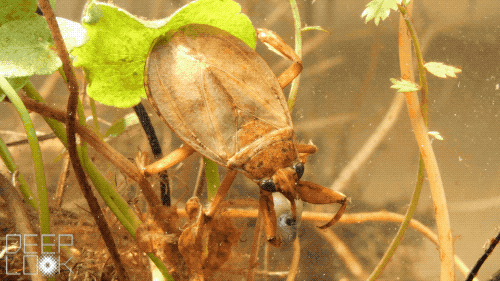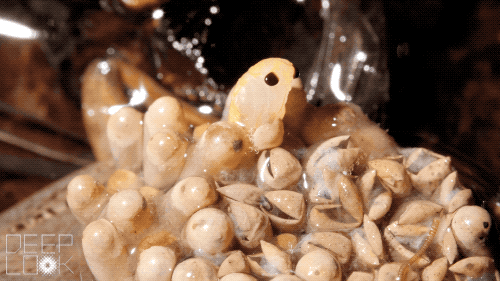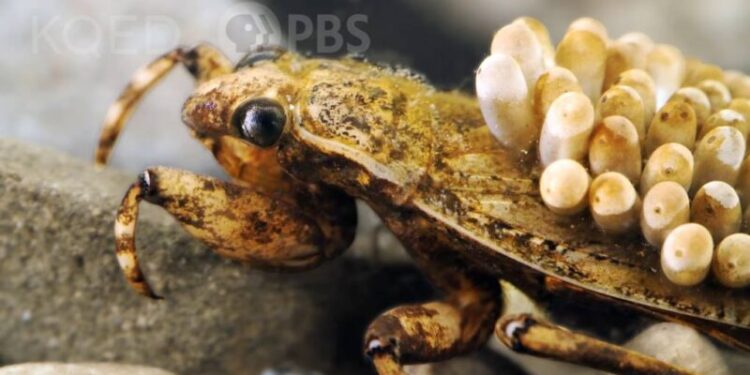Several species live in California’s ponds and streams, and most measure about the length of your thumb. When park rangers in the Santa Monica Mountains found healthy populations of giant water bugs near popular swimming holes in 2018, they warned the public to beware of their particularly unpleasant bites.
But our toes aren’t what water bugs are after. Giant water bugs prey on other aquatic insects, as well as animals as large as turtles, snakes and even ducklings — one naturalist in the 1800s even recorded one ambushing and devouring a woodpecker. Using their powerful, vice-grip legs, they subdue their victim before stabbing into it and injecting venom that liquefies the insides of their prey.
“They wait for everything to dissolve, and suck it back out,” says Chris Goforth, an entomologist and manager of citizen science at the North Carolina Museum of Natural Sciences. “Almost certainly, it’s still alive when it’s being eaten.”
 A giant water bug injects a fish with paralyzing digestive enzymes before slurping out the liquefied insides. (Josh Cassidy/KQED)
A giant water bug injects a fish with paralyzing digestive enzymes before slurping out the liquefied insides. (Josh Cassidy/KQED)
Despite their aggressive and predatory nature, giant water bugs might just be the most responsible fathers in the insect world. In some California species, dad will haul his eggs around piggyback style for weeks, until they hatch right off his back.
“Parental care is unusual in itself,” says Sites, “but then actually attaching the eggs to the males — that’s another layer of complication.”
 Male giant water bugs in the Abedus genus, like this Abedus indentatus in California, carry their eggs around piggyback style throughout their development. (Josh Cassidy/KQED)
Male giant water bugs in the Abedus genus, like this Abedus indentatus in California, carry their eggs around piggyback style throughout their development. (Josh Cassidy/KQED)
After mating, a female climbs onto the male’s back to lay row after row of eggs, gluing each one with a gooey substance oozing from her reproductive glands. Mom’s work ends here, and she swims off to prowl the shadows for her next meal.
But for dads, their job has only started. Most insects leave their eggs defenseless, relying on sheer numbers to get some of them through to hatching. By carrying the eggs on their backs, giant water bug dads can dodge predators and keep an eye on their babies. They’ll carry these eggs for weeks, shuttling them to the surface for air like an insect minivan.
“They’ll just bob up and down, ever so slightly,” says Hope Klug, an ecologist at the University of Tennessee at Chattanooga. “With the movement, they’re making sure that each individual egg is getting some oxygen to help it develop.”
After several weeks, the eggs have doubled in size and turned a milky white color. Suddenly, a pair of eyes is visible through each egg casing: The nymphs inside are getting ready to hatch. Within a few days, a transparent nymph pushes through, face first, unfolding its long limbs as it emerges.
 A nymph emerges from its egg casing after weeks of being shuttled around on dad’s back. (Josh Cassidy/KQED)
A nymph emerges from its egg casing after weeks of being shuttled around on dad’s back. (Josh Cassidy/KQED)
Once it’s fully hatched, the nymph quickly swims away. If dad catches it, his instincts will kick in. Despite the weeks of careful parenting that he dedicated to ensuring the eggs’ survival, his offspring are now fair game as a tasty snack.
Sabrina Mendoza-Espinoza, who cares for more than a dozen water bugs on display at the San Francisco Zoo, put it this way: “They’ll go after anything that moves.”
Including their own children.




















